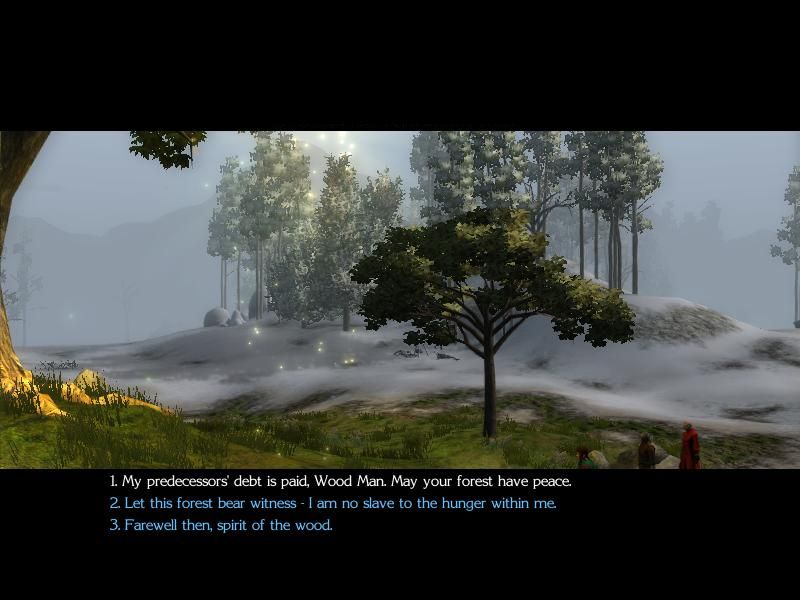Part 18: Nullius In Verba
Act Two Chapter Ten - Treebeard's Great-Grandpappy
In case you were wondering, refusing to help Nadaj with her revolt doesn't change much - she still sics the berserkers on you, just immediately instead of after killing Dalenka. What does change is that you can then talk to Dalenka about what happened and, with a skill check, get her on side for the confrontation with Nadaj.But I think it's more dramatic to wipe out the Lake of Tears garrison, so it's curtains for Dalenka.
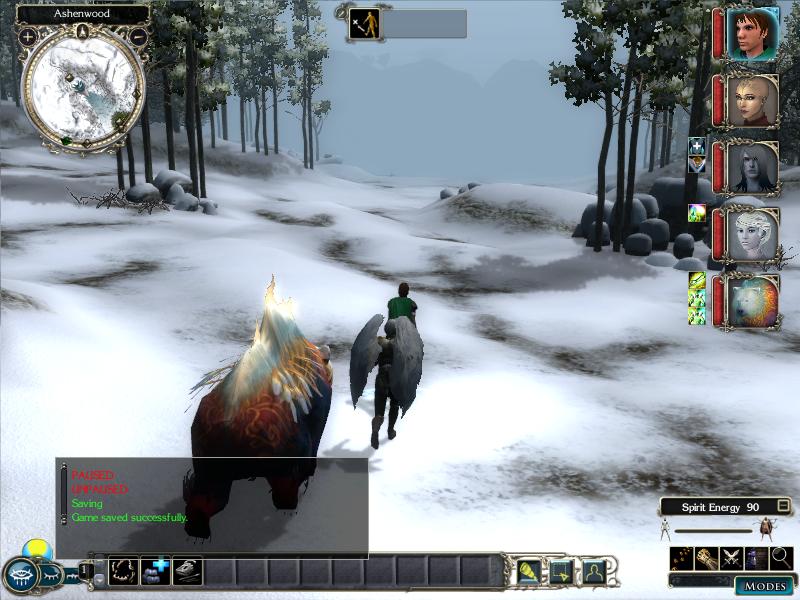
Anyway, we're in hot pursuit! Slap the sirens on Okku, we've a rogue ethran to catch!
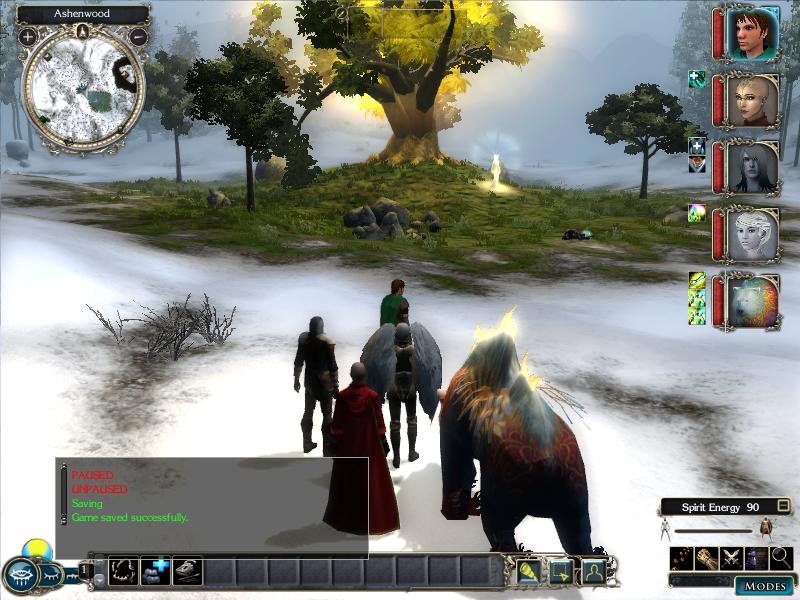

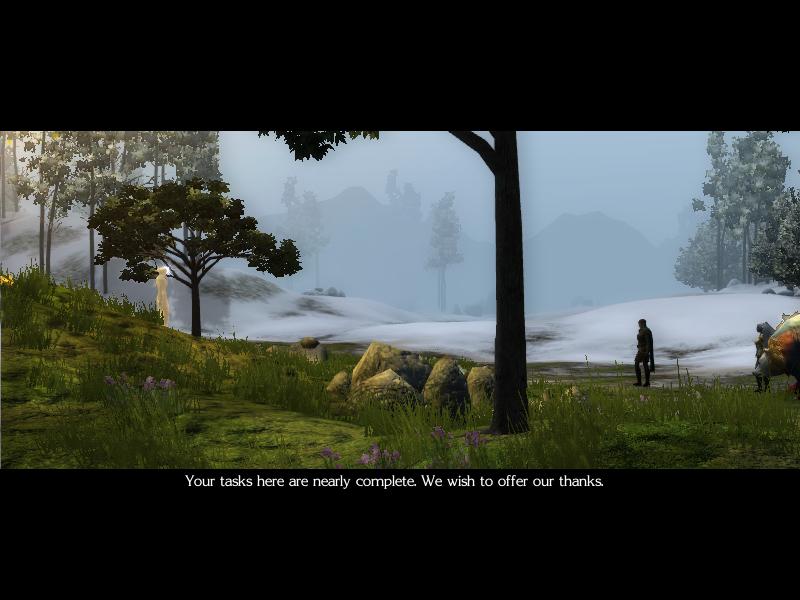
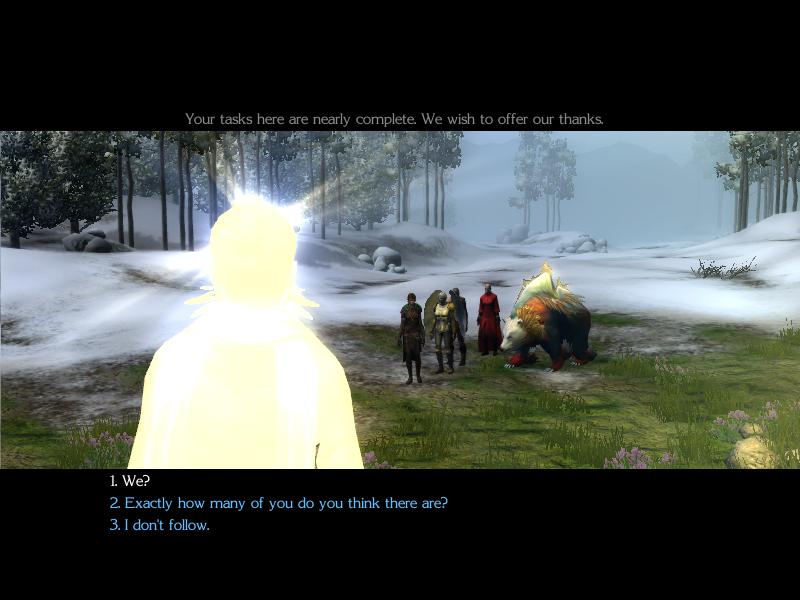
That ain't no spell buff I ever seen...
 : We. We are the outrage, the fury, the vengeance. We are one.
: We. We are the outrage, the fury, the vengeance. We are one. : Long have we festered, desiring only to protect, yet bound and suppressed by the one who purports to speak for these woods.
: Long have we festered, desiring only to protect, yet bound and suppressed by the one who purports to speak for these woods. : He has failed. Has faded to nothing. Now we are all that protects. We are the need, the distress, the suffering.
: He has failed. Has faded to nothing. Now we are all that protects. We are the need, the distress, the suffering. : And you betrayed me... why, exactly?
: And you betrayed me... why, exactly?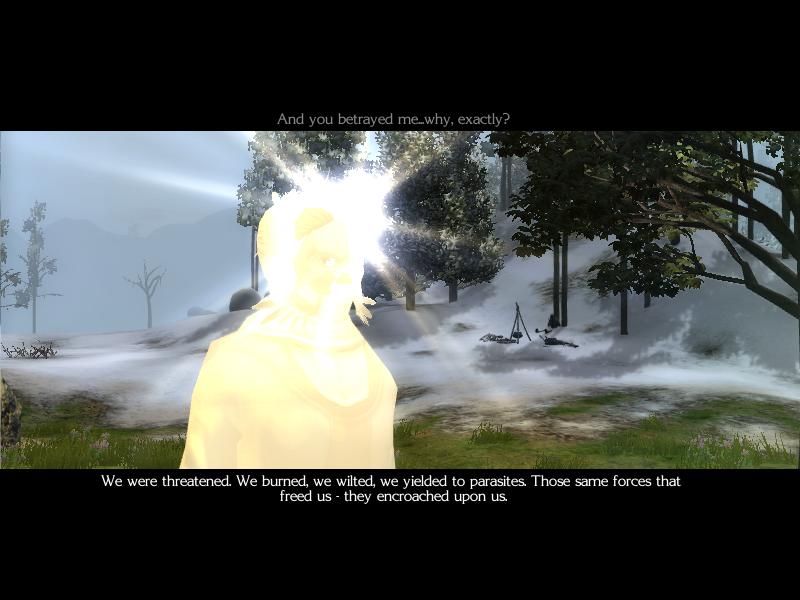
 : We needed them gone, and you obliged. We are grateful.
: We needed them gone, and you obliged. We are grateful. : Who am I talking to, here?
: Who am I talking to, here? : This woman... she is a shell, a garment worn by the feral instinct of the forest. Ashenwood, I fear, is about to shed this husk, and our blood may soon follow.
: This woman... she is a shell, a garment worn by the feral instinct of the forest. Ashenwood, I fear, is about to shed this husk, and our blood may soon follow.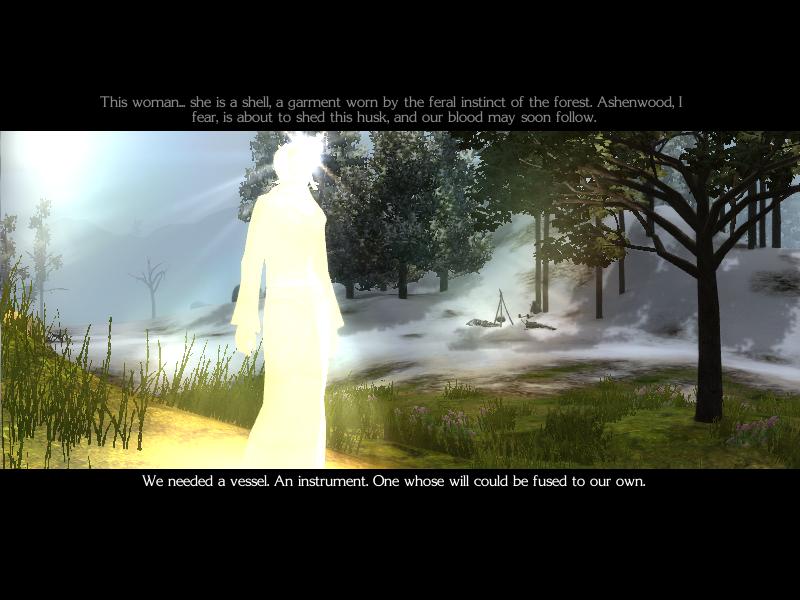
 : We took the ethran. We are the protector. We are the land. We are one.
: We took the ethran. We are the protector. We are the land. We are one. : I'm getting really tired of listening to you talk.
: I'm getting really tired of listening to you talk. : We ask that you help us. That you remove the remaining threat.
: We ask that you help us. That you remove the remaining threat.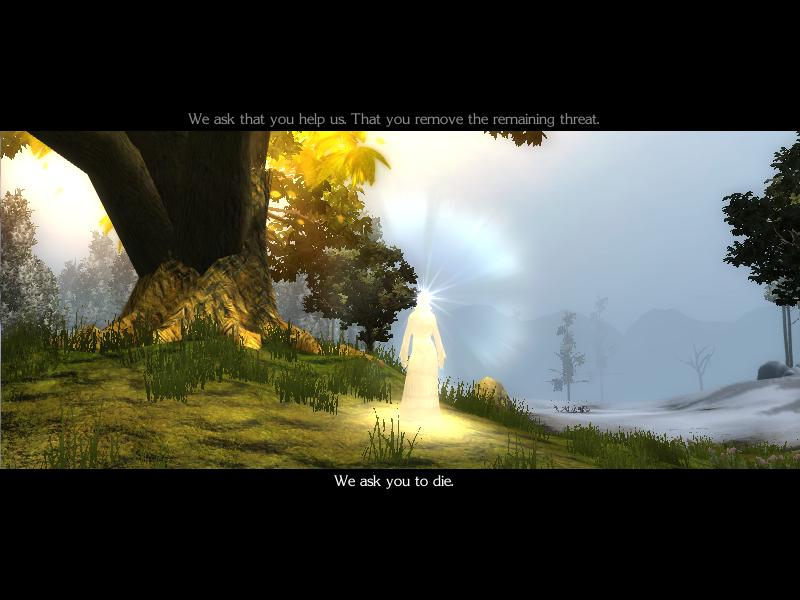
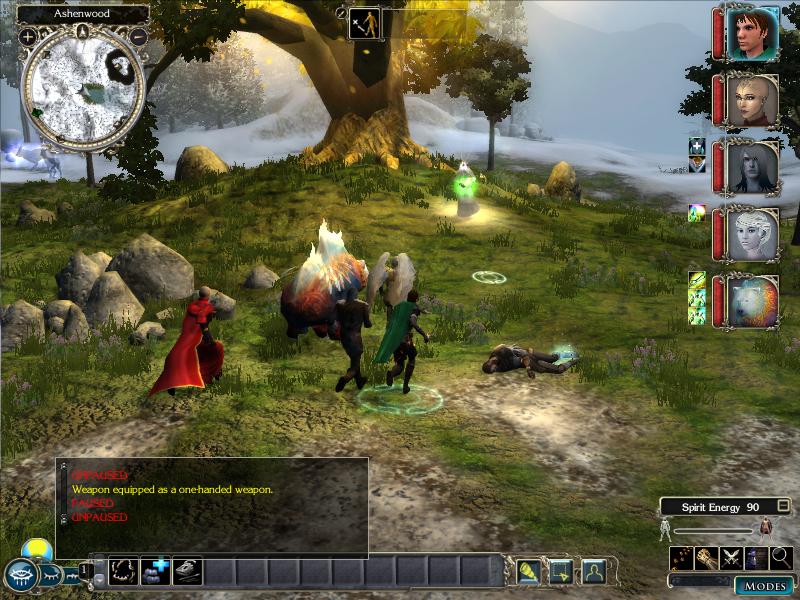
Ashenwood Combat
So what's going on with Nadaj?
If I said she was a Colossal Ooze, would that shed any light?

With the Wood Man absent, Ashenwood has fallen under the sway of a genius loci - the non-intelligent 'guardian spirit' of a place. Genius loci is an old Roman concept for the godling or spirit of a particular grove, shrine or spring, but in the Forgotten Realms genii are exactly as Gann described: the feral nature of a place.
Genii don't have any higher reasoning beyond "protect and destroy" but they can possess other living beings, as this one did Nadaj, and use their minds to come up with plans. Like, for example, getting the local spirit-eater to eliminate invading giants and troublesome fire-spirits, then betraying her catspaw to Rashemi berserkers.
It's another one of those Epic monsters.
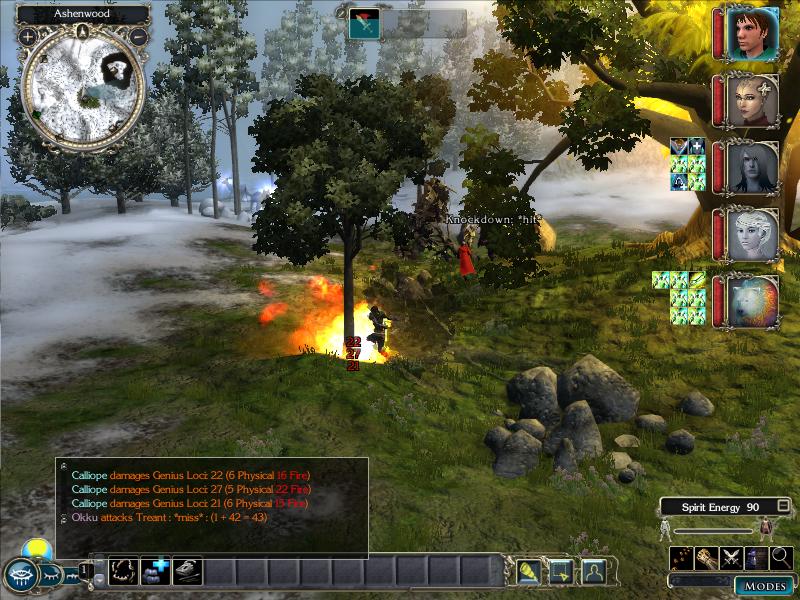
This battle is quite similar to the Okku fight, in that it's five adventurers versus a limitless army of puny minions. The Treants, Elementals, etc. are spawned by the five genius loci trees in the central hub area; the genius loci itself will also throw out spells like Earthquake, Dominate Person, Contagion and the like. All five trees must be cut down before the battle can end. What's different is that this time the minions get weaker as you hurt the main monster, because fewer trees leads to fewer minions summoned.
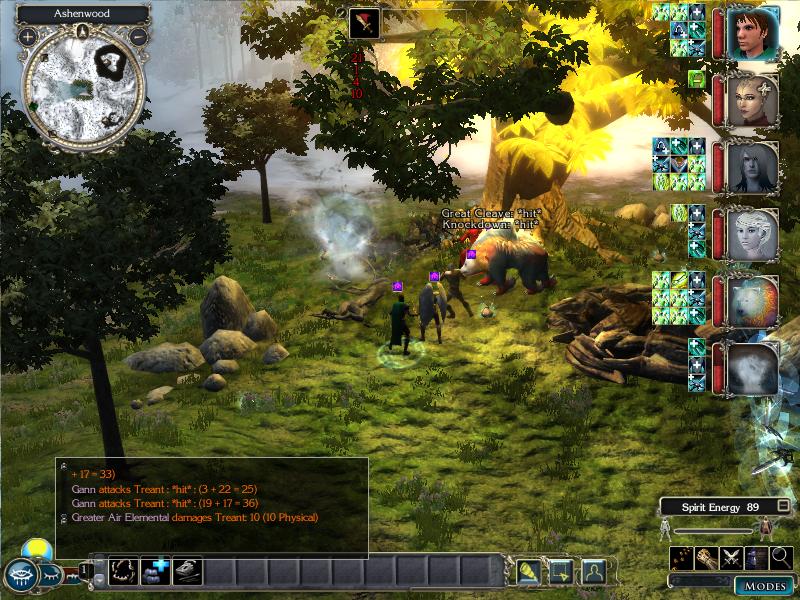
But we don't have anything to worry about. In fact there's nothing stopping us from sitting here all day, farming Treants for XP, because as Epic-level adventurers we're practically immortal, five party members or no. In addition to 6d6 elemental damage, for example, Calliope has also finally gotten Epic Precision, allowing half our Sneak Attack damage on normally-immune enemies.
This fight is basically the inverse of the West Harbor Swamp Ruins from the NWN2 OC. We've gone from one unlucky dice roll away from death, to being almost unstoppable.
* * *
I've always been a little confused about the difficulty/progression metric in D&D (and in most games in general). It's always seemed a little backwards to me, and the whole Level 1/Level 30 opposition exemplifies it. But I think the best way to express this is with this picture of a preview of popular first-person-shooter Quake...
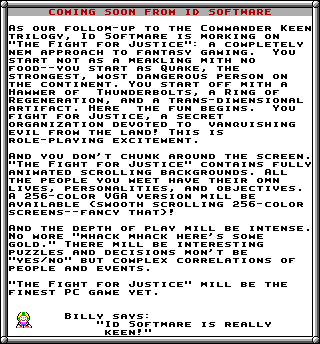
...or should I say, 'The Fight For Justice'.
This is from one of the Commander Keen platformers - a sneak preview of ID Software's next project. It doesn't sound like Quake, but this was back when John Romero was still at ID and designing games, and he always preferred fantasy to sci-fi.
What drew my attention was the line, "You start not as a weakling with no food - you start as Quake, the strongest, most dangerous person on the continent." It's interesting because, of course, that's not how it ended up at all; in Quake you started each episode with a shotgun and a handaxe and you bloody well earned that rocket launcher.
The basic idea behind difficulty in games is to start off easy, while players adjust to new mechanics and controls, then ramp up the difficulty as you progress through the game. Enemies become stronger, timers get shorter, recovery items less frequent - the dual purpose is to both a) make the game more engaging to players who have mastered the controls, and b) winnow out poorer players, to differentiate masters from novices and to give players something to work towards. This is the basic M.O. of your typical arcade game, in essence, but every game does this - and in Mask, there are some truly difficult fights.
Reasonable, yuh?
But at the same time you've got this other progression path present that contradicts increasing difficulty: rewards. The further in the game you get, the more rewards you get - and I mean rewards beyond cutscenes and high scores. You get gold, magic items, experience... rocket launchers, plasma guns, solar power plants, Gravity Suits, Mammoth tanks... and the contradiction I see here is that all these rewards are designed to make the game easier. In fact, in some games, they're fucking essential to survival.
I don't get why designers would do this. Maybe I value simplicity too strongly, but wouldn't it be more elegant to stick to one or the other? Either make the game more difficult by requiring more skill to progress, with Iron Golems and Barons of Hell and whatnot, or make it easier by rewarding progress, with Holy Avengers and BFGs and so on.
Okay, so orthodoxy says to balance the two like so:
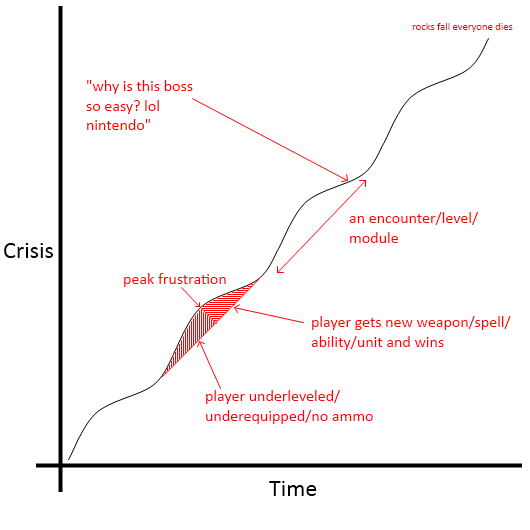
where "Crisis" is a combo of pure difficulty, player rewards and the 'stakes' at play (using +1 short sword against kobolds is low crisis, saving the world from dragons with Meteor Swarm is high crisis) (yes I know it's not mathematical shut up)
But then you get that oscillation pattern where you're either struggling against overly-strong enemies, or hacking them down with a reward. Those humps are representative of the gap between a Level 4 Wizard running from orcs, and the same Wizard gaining a level and casting Fireball. Now, ideally it's a very gradual, controlled curvature, with individual sudden drops/rises scripted by designers to inject drama (like every time Gordon Freeman discovers a cache of ammo in Half-Life 2) but players are a variable bunch and inevitably it breaks down - or the system itself is too brittle to support the gradient, and that's where 5hp Wizards and 200hp Rogues come from.
My thinking is: why not try a straight line? Why make the player earn the most powerful items and units? Start the player off with Archons and Mammoths, and let him stomp all over the opposition... then introduce challenge by taking away his shiny toys and making him use crappy infantry and smart tactics against an overpowered foe. Give the player the Hammer of Thunderbolts and Ring of Regeneration... but they wear down with time, and they have to last him the whole game. With such a structure in place, would you be able to kill twenty-two bosses in five minutes?
I call this the 'John McClane' model, because the idea is that difficulty arises from accumulative fatigue/loss of resources/increasing injury, rather than arbitrarily more difficult terrorists with improbably higher hit points. It's a bit grim and discouraging, but I reckon it could appeal to a certain mindset. And for others, there's the "Stairway to Heaven" model of casual gaming, so all's good.
This was a little more in-depth than I intended - I just wanted to explore some reasons why D&D is so badly balanced at low- and high-levels. Well, there you go anyway.
* * *
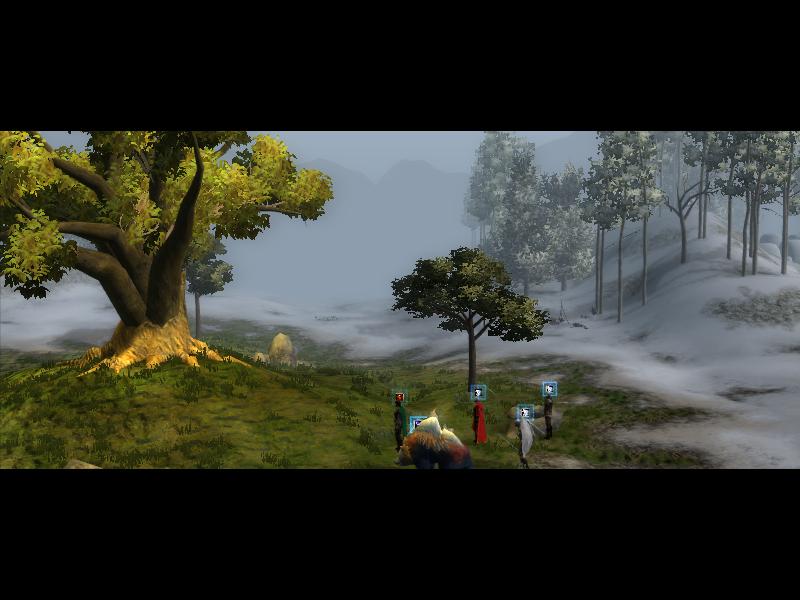
BUT I DIGRESS
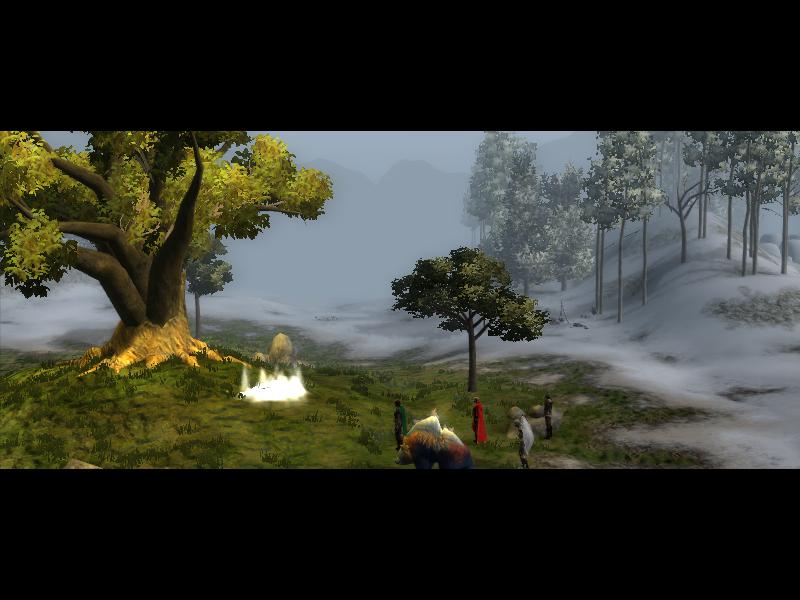
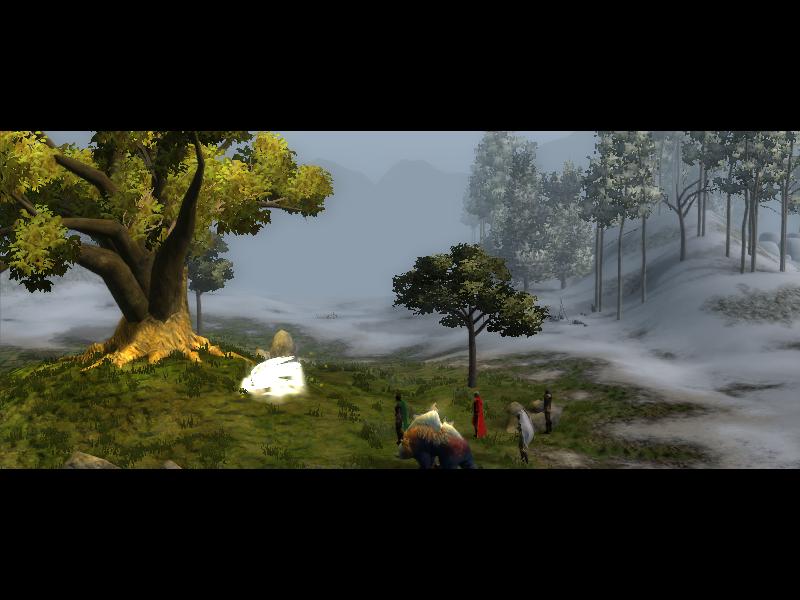
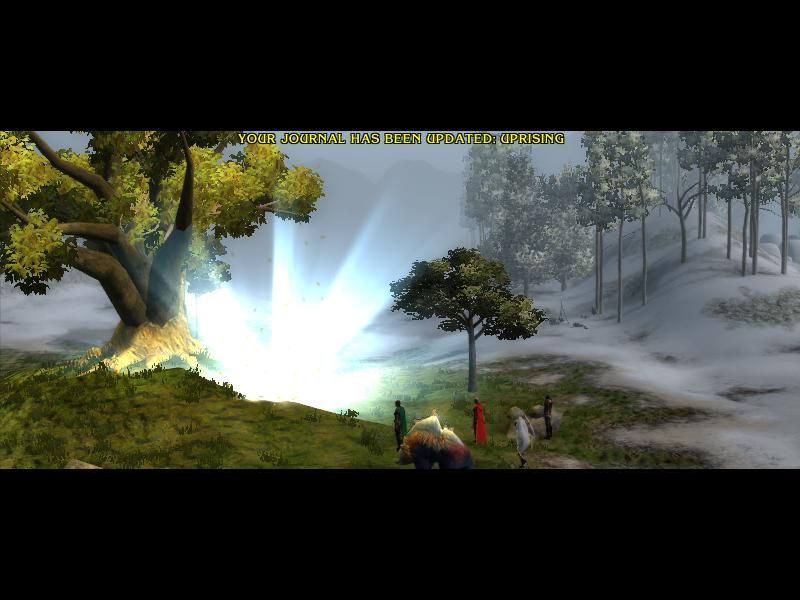
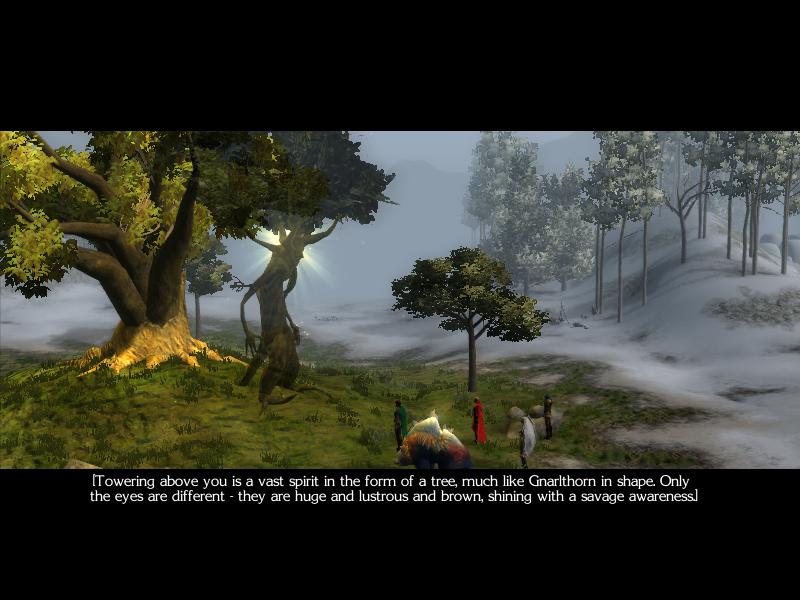


I wound up having to do a second run-through of the Wood Man conversation, because with five party members Okku kept getting in the way of the camera. So don't be alarmed if he suddenly disappears half-way through.
 : It is him...
: It is him... : [A wind rises across the surrounding trees, like the first breath of some reawakening god. The mouth of the tree spirit opens soundlessly, but a silence is suddenly lifted from the forest... an unnatural quiet that you never realized was there, until now.]
: [A wind rises across the surrounding trees, like the first breath of some reawakening god. The mouth of the tree spirit opens soundlessly, but a silence is suddenly lifted from the forest... an unnatural quiet that you never realized was there, until now.]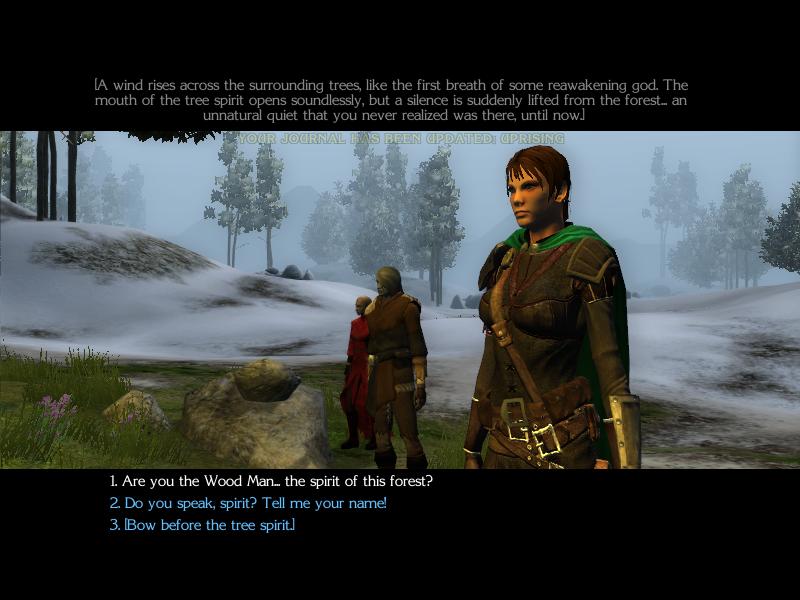
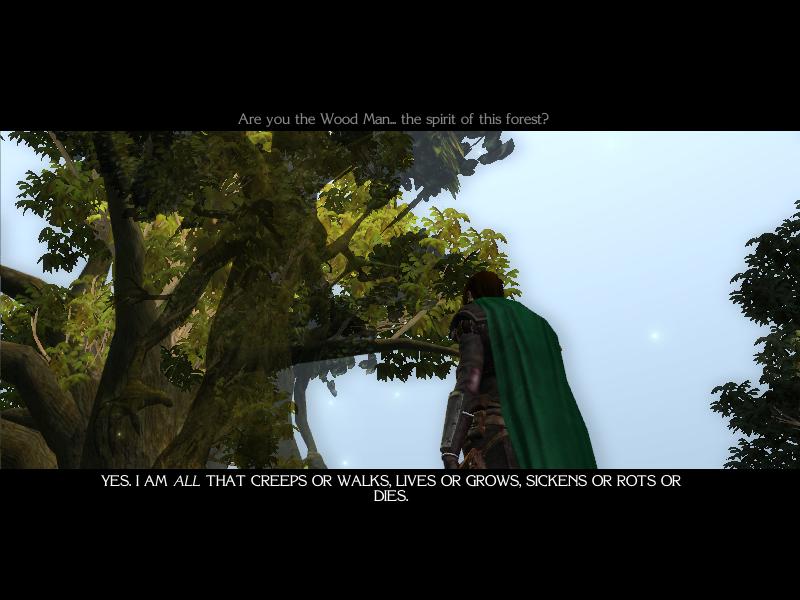
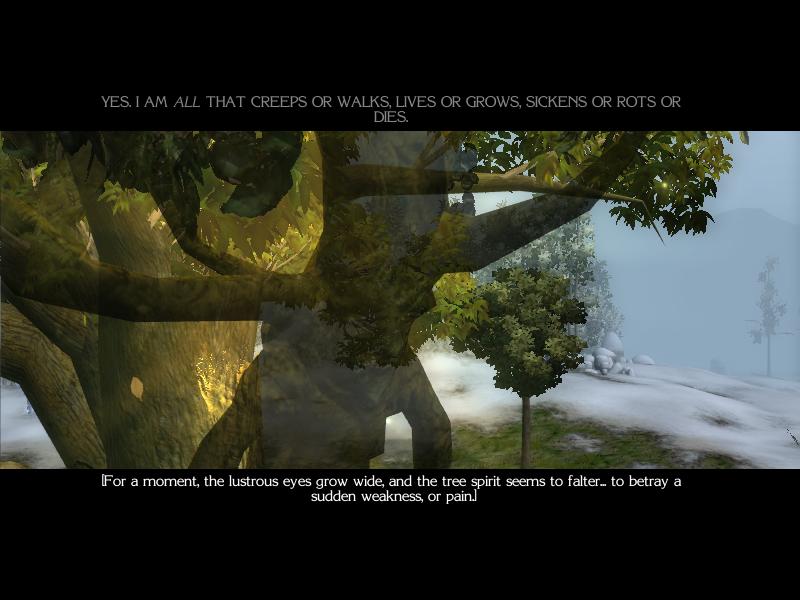
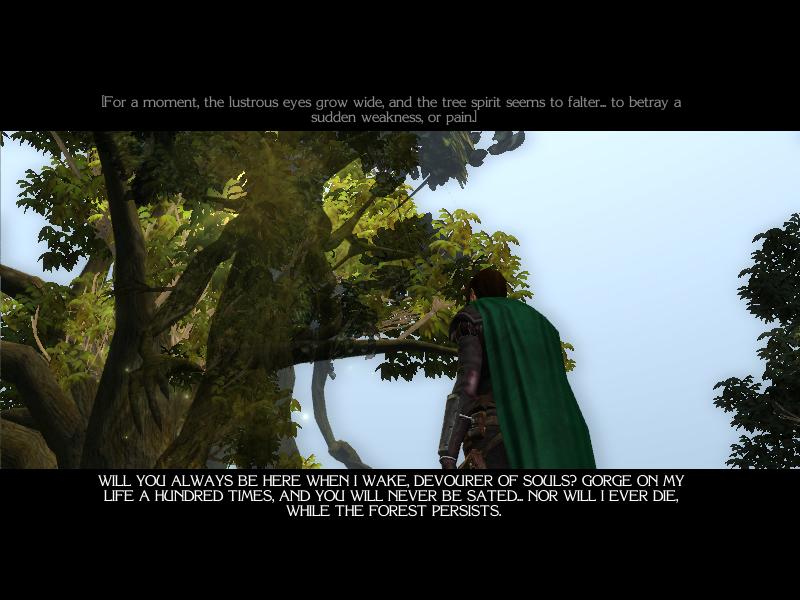
That's not nice

 : We have never met. Perhaps you speak of another spirit-eater, who came before?
: We have never met. Perhaps you speak of another spirit-eater, who came before? : THE FACE CHANGES... THE HUNGER REMAINS THE SAME. WHY DID YOU SLAY THE PARASITE AND CALL ME FORTH, IF NOT TO FEAST ONCE AGAIN?
: THE FACE CHANGES... THE HUNGER REMAINS THE SAME. WHY DID YOU SLAY THE PARASITE AND CALL ME FORTH, IF NOT TO FEAST ONCE AGAIN? : The 'parasite'... the evil spirit in the tree. What was it?
: The 'parasite'... the evil spirit in the tree. What was it?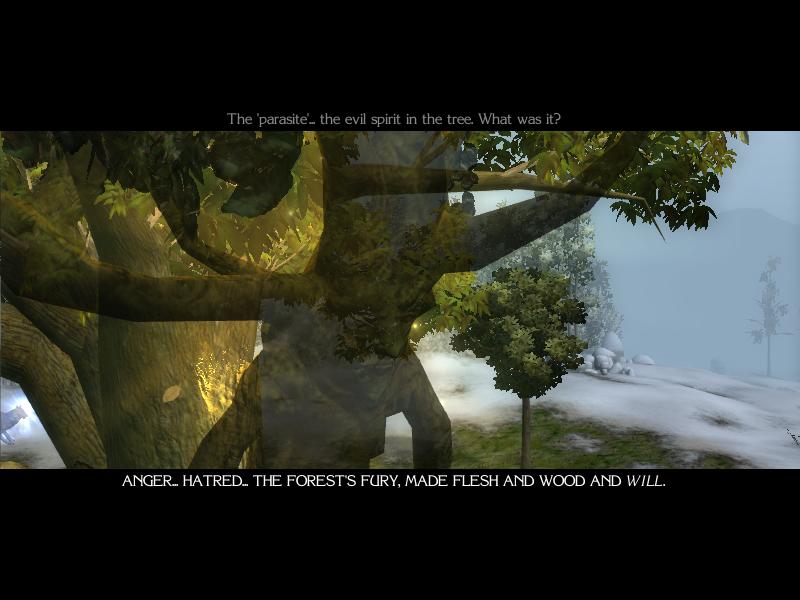
 : YOUR HUNGER DISPERSED MY SOUL, AND THAT FURY AROSE IN MY PLACE.
: YOUR HUNGER DISPERSED MY SOUL, AND THAT FURY AROSE IN MY PLACE. : ...IT SEEPED INTO THE SOULS OF THE SMALL ONES, THE GENTLE ONES, AND SLEW THEM... CALLED TO THE FOULER ONES AND DREW THEM HENCE.
: ...IT SEEPED INTO THE SOULS OF THE SMALL ONES, THE GENTLE ONES, AND SLEW THEM... CALLED TO THE FOULER ONES AND DREW THEM HENCE. : Why did it ensnare Nadaj?
: Why did it ensnare Nadaj?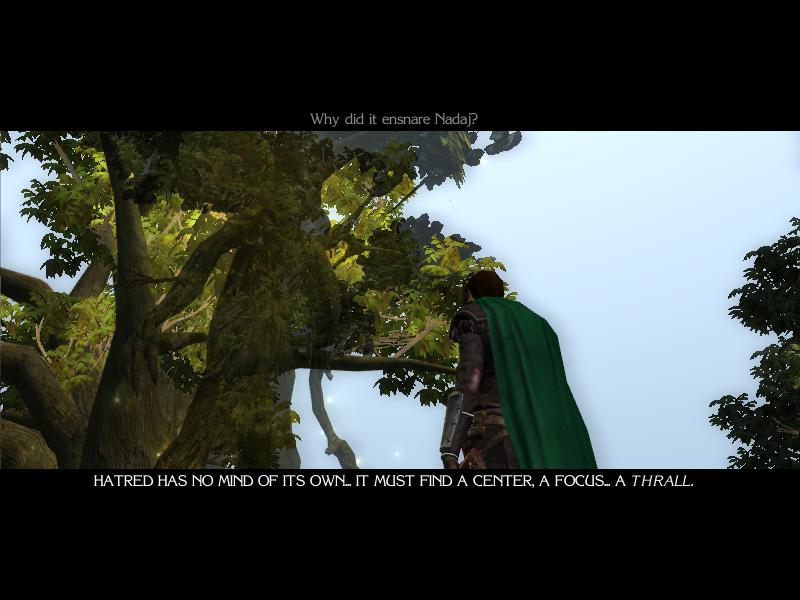
 : THROUGH HER MIND AND HER VOICE, THE PARASITE SCHEMED AND AVENGED.
: THROUGH HER MIND AND HER VOICE, THE PARASITE SCHEMED AND AVENGED. : And the parasite... was it preventing your return?
: And the parasite... was it preventing your return? : YES. WHILE I WAS DISPERSED, THE ANGER GREW TOO STRONG.
: YES. WHILE I WAS DISPERSED, THE ANGER GREW TOO STRONG. : THE HATRED... THE PARASITE... HAD TO BE TORN FROM THE FOREST'S HEART BEFORE I COULD EMERGE AGAIN.
: THE HATRED... THE PARASITE... HAD TO BE TORN FROM THE FOREST'S HEART BEFORE I COULD EMERGE AGAIN.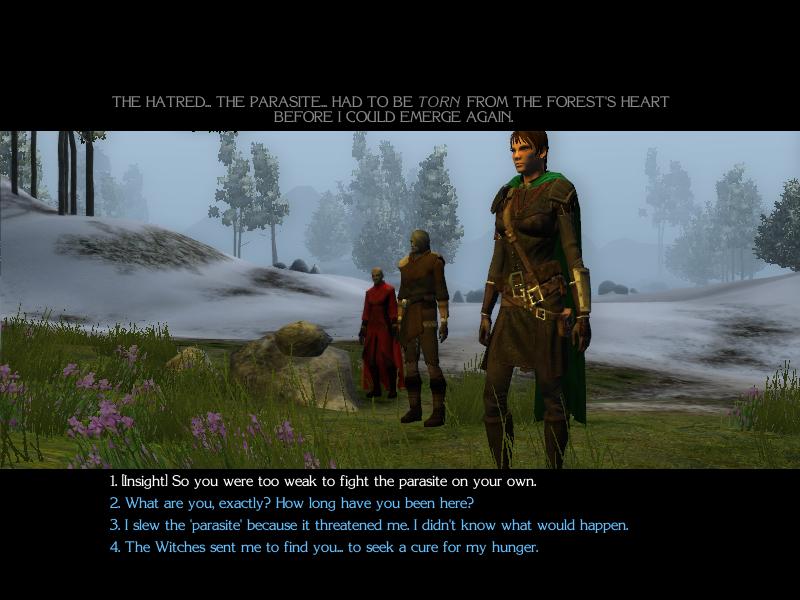
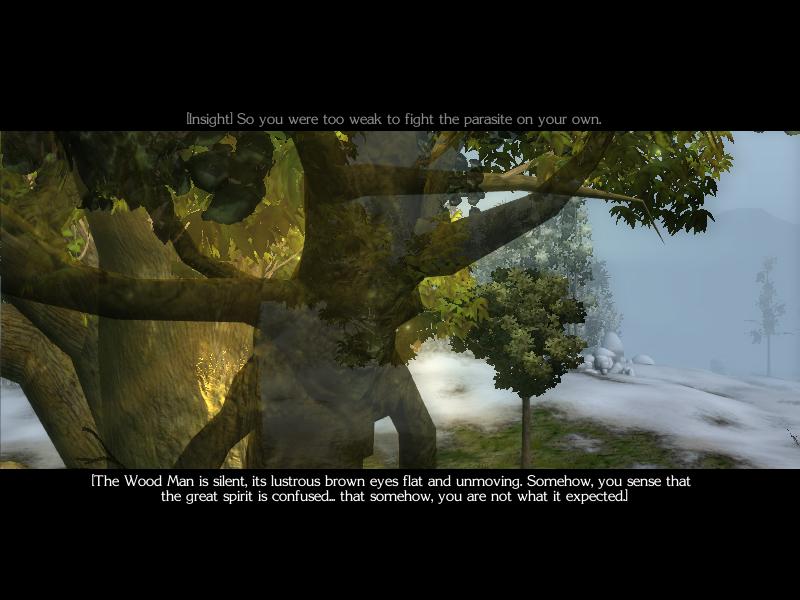
 : YES. I WAS... AND AM... TOO WEAK.
: YES. I WAS... AND AM... TOO WEAK.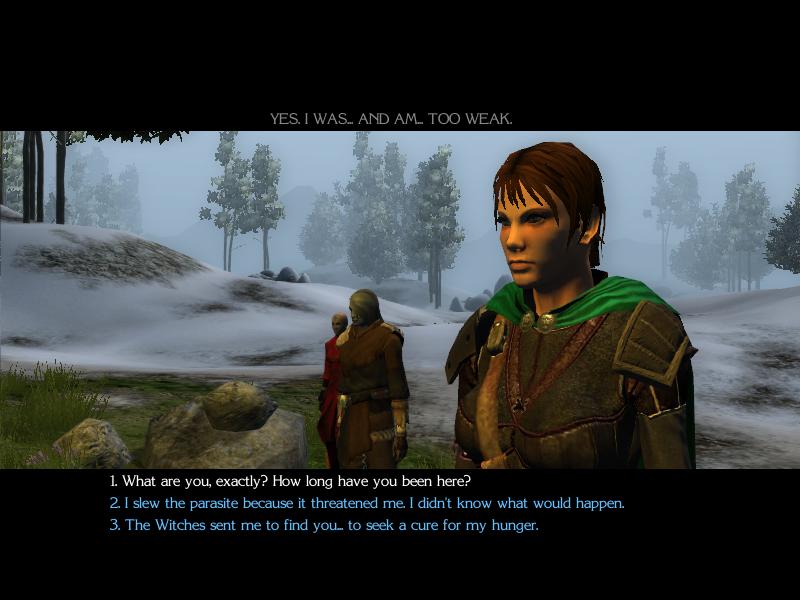
There have been many Wood Men throughout history... the gods of forests - not of general trees and treesiness, but this forest, our forest. Think of Greek dryads or of Slavic leshoviks.
And trees have always been respected and worshipped, because of their strength, durability, presence, the way they die in autumn and return in spring (just as the world does and just as Man hopes to as well). Again, Christmas trees, the Bodhi tree, the Tree of Knowledge.
What I want you to think is that the Wood Man is a representation of God and we are His pilgrims.
 : MY SPIRIT RODE UPON THE SEEDS THAT DRIFTED TO THIS PLACE FROM FAR OVER THE MOUNTAINS, WASHED IN MEMORIES OF VERDANT PLAINS AND PURPLE STONE.
: MY SPIRIT RODE UPON THE SEEDS THAT DRIFTED TO THIS PLACE FROM FAR OVER THE MOUNTAINS, WASHED IN MEMORIES OF VERDANT PLAINS AND PURPLE STONE. : CHAUNTEA, MIELIKKI, LURUE... I KNEW THEM AS BEASTS, SAVAGE MATRONS OF THE HUNT, LEADING THEIR PACKS BENEATH MY BOUGHS... BEFORE THE DREAMS OF MEN CHANGED THEM INTO MILD, DOCILE THINGS.
: CHAUNTEA, MIELIKKI, LURUE... I KNEW THEM AS BEASTS, SAVAGE MATRONS OF THE HUNT, LEADING THEIR PACKS BENEATH MY BOUGHS... BEFORE THE DREAMS OF MEN CHANGED THEM INTO MILD, DOCILE THINGS.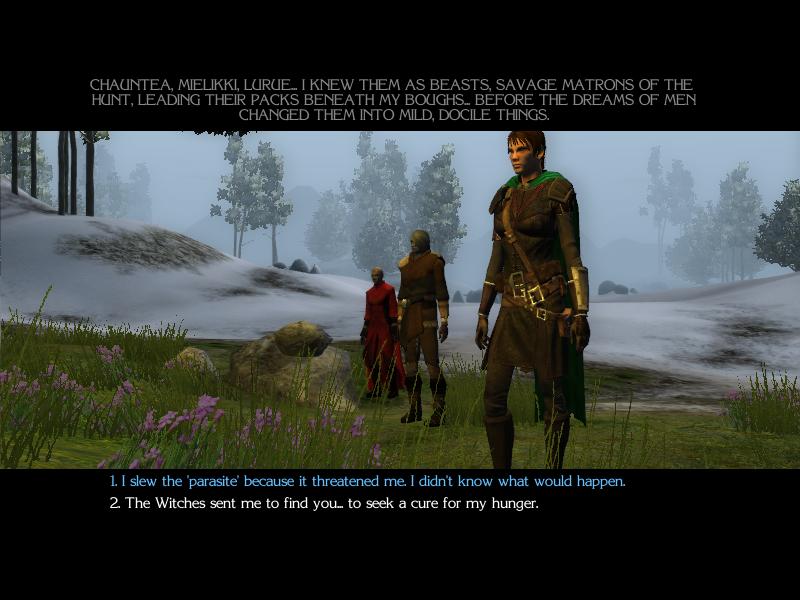
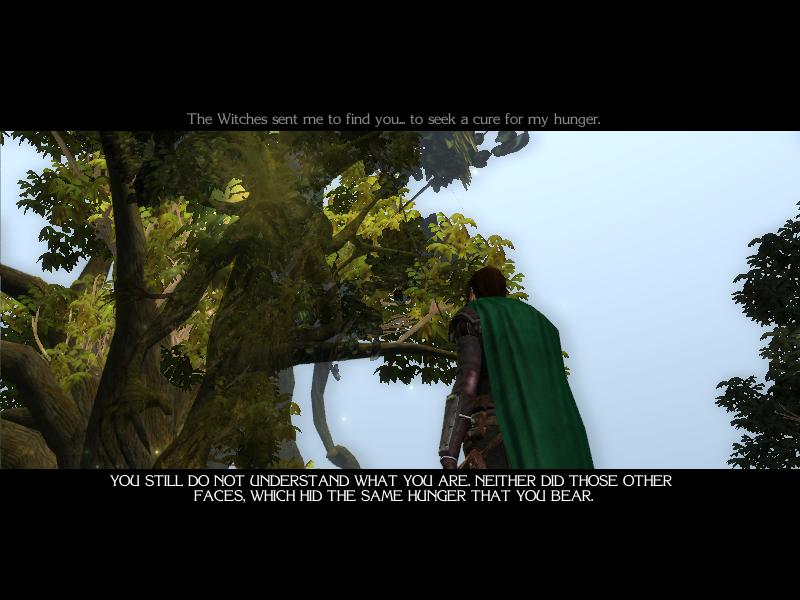
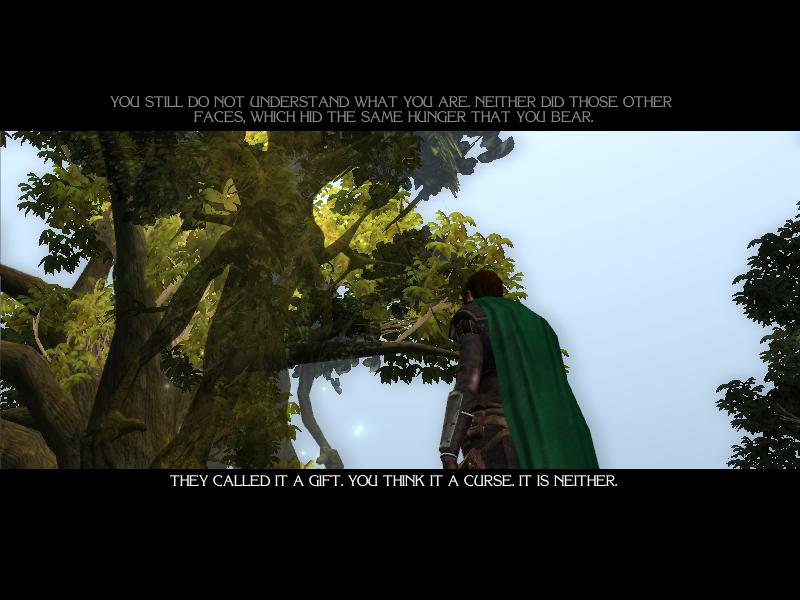
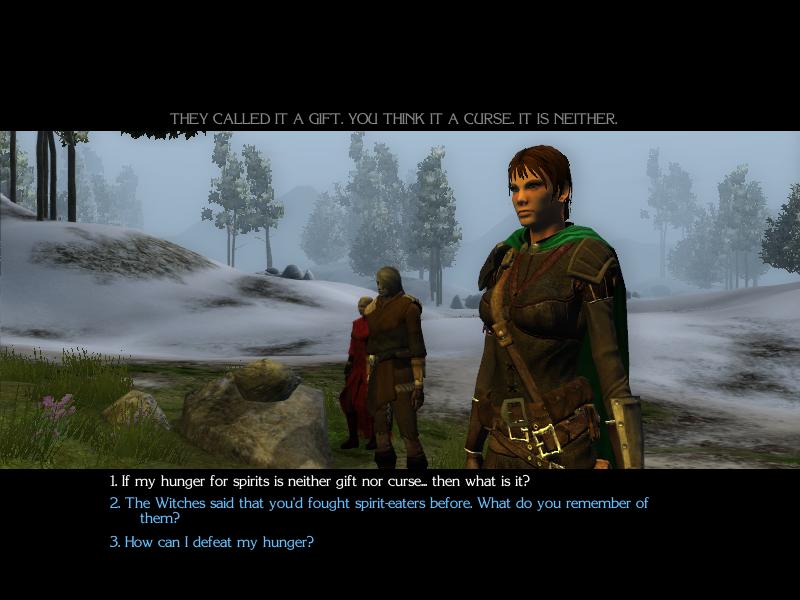
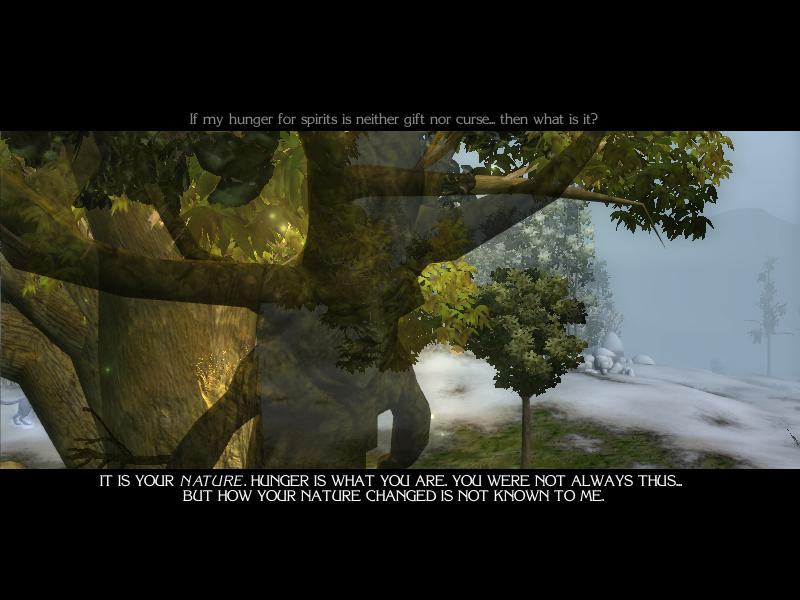
What can change the nature of a man?
Sorry, wrong game.
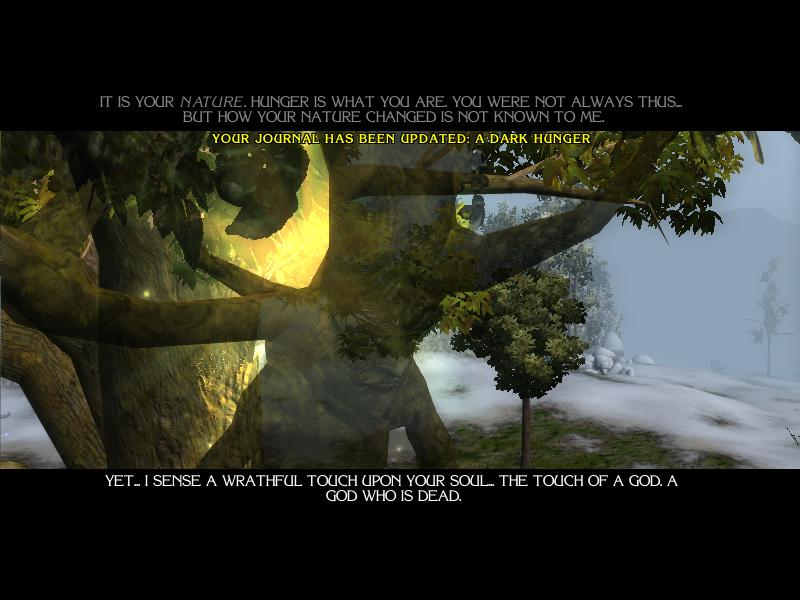
Fucking gods again! I hate the Forgotten Realms!
 : You believe that a dead god somehow changed my nature... cursed me with this hunger? That seems unlikely.
: You believe that a dead god somehow changed my nature... cursed me with this hunger? That seems unlikely. : A dead god nearly killed you when you tried to escape his barrow. Not all that is dead lies still.
: A dead god nearly killed you when you tried to escape his barrow. Not all that is dead lies still. : A DEAD BOAR MAY FALL INTO A STREAM, PUTREFY, AND CORRUPT THE WATERS. A DEAD TREE MAY TOPPLE AND ROT, PROVIDING LIFE FOR A MILLION SWARMING ANTS.
: A DEAD BOAR MAY FALL INTO A STREAM, PUTREFY, AND CORRUPT THE WATERS. A DEAD TREE MAY TOPPLE AND ROT, PROVIDING LIFE FOR A MILLION SWARMING ANTS. : So a dead god somehow changed my nature. But which god, and why?
: So a dead god somehow changed my nature. But which god, and why?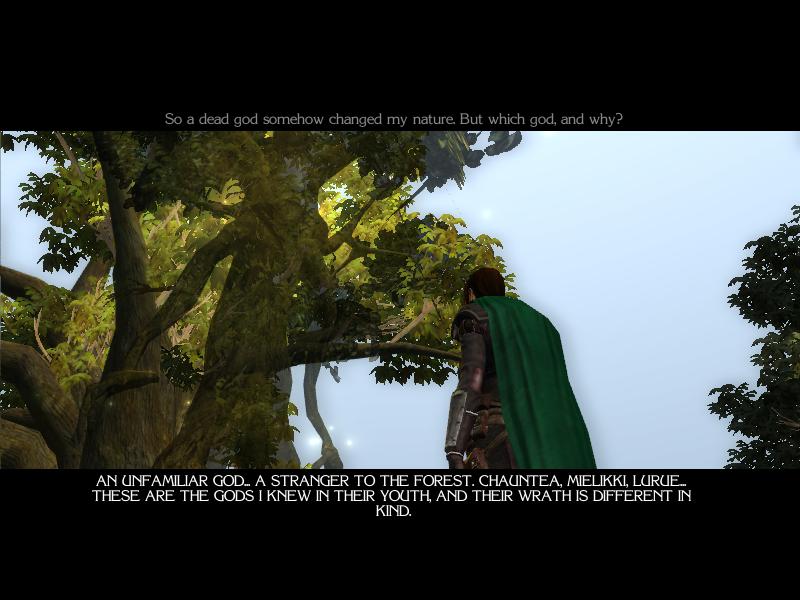
We shouldn't be surprised the Wood Man can't help us. As I mentioned, the whole Ashenwood module was a last-minute fit. Weirdly, Obsidian were actually ahead of schedule for Mask of the Betrayer and decided to fit in another module's worth of content.
Don't get me wrong, it's not a rush-job at all. Okay, so the creatures used in the toolset aren't organised neatly into area-specific categories, but the actual game-content itself is fine. The most you can say is that companion interaction is a little sparse, but that's not always a bad thing. And, like Kaelyn, it's a seamless fit; I'd've never have expected it. Then again, I can't quite recall where I read this information, so I could be entirely mistaken. Take my words with a grain of salt.
Anyway, it's funny because this is the most Rashemen-esque area in the game. We'll see Imaskari ruins, Thayan academies and the inside of dreams before this game is through, but this is the last time we see any authentically Rashemi locations or creatures. Let's be honest: Mulsantir is Neverwinter in fancy dress.
 : The Witches said that you'd fought spirit-eaters before. What do you remember of them?
: The Witches said that you'd fought spirit-eaters before. What do you remember of them?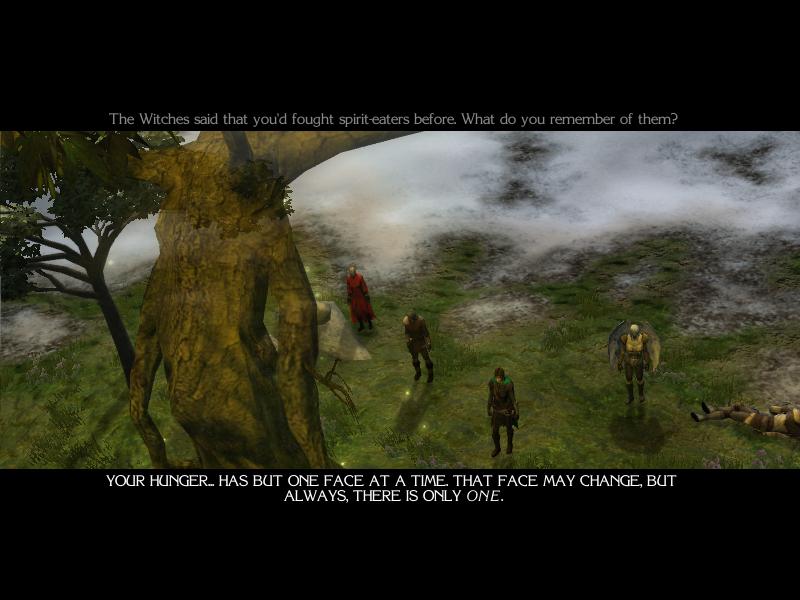
 : So... there is only one spirit-eater at a time. Do you remember anything more?
: So... there is only one spirit-eater at a time. Do you remember anything more? : YES. THE FACES ALWAYS PERISH. THE MORE THEY EAT, THE MORE THEY MUST EAT.
: YES. THE FACES ALWAYS PERISH. THE MORE THEY EAT, THE MORE THEY MUST EAT. : AND THE HUNGER DEVOURS THEM... BURNS THEM FROM INSIDE... AND PASSES TO A NEW FACE.
: AND THE HUNGER DEVOURS THEM... BURNS THEM FROM INSIDE... AND PASSES TO A NEW FACE.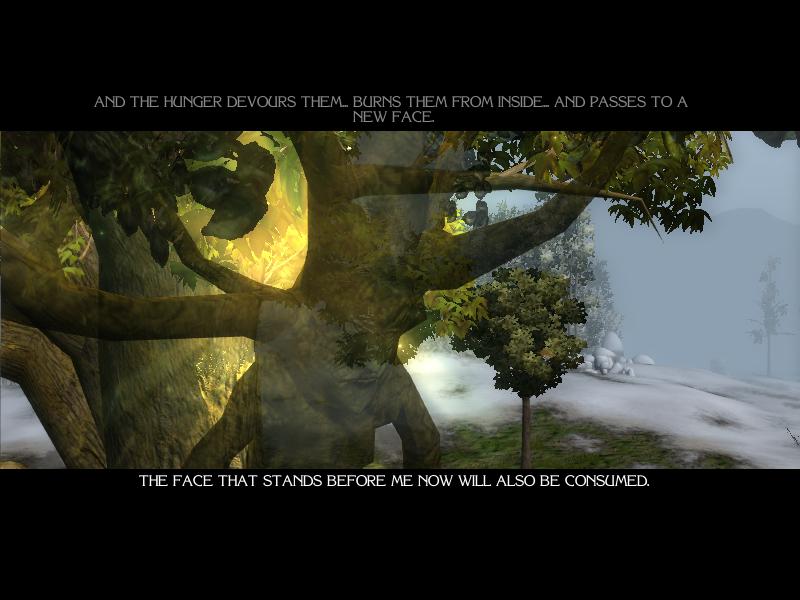
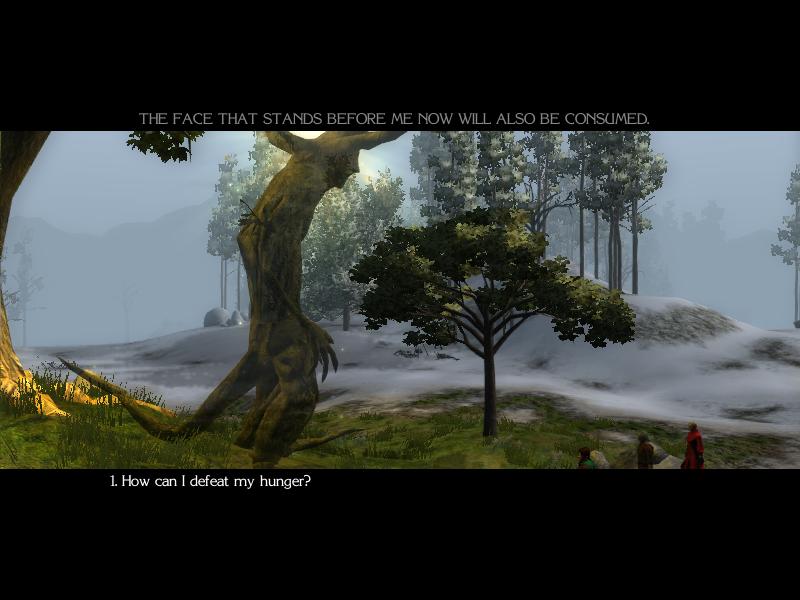
This is it... this is the money shot.
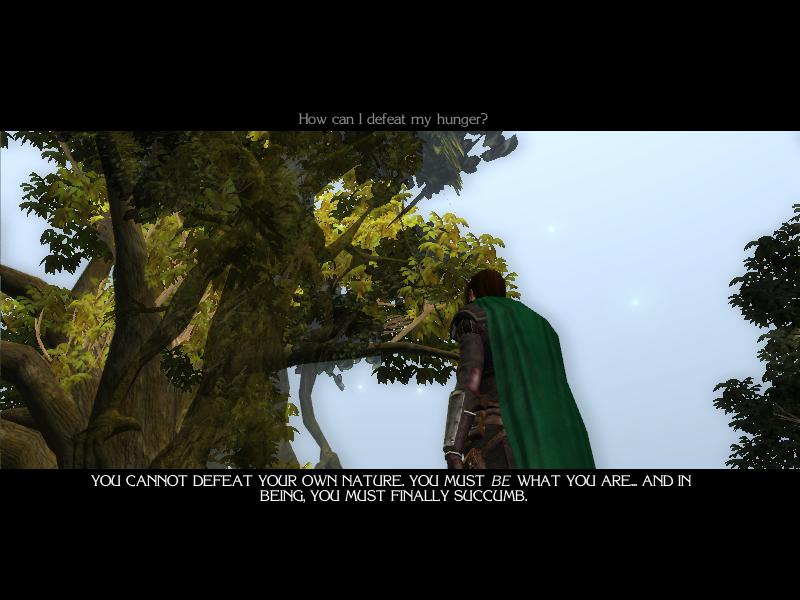

 : TO CHANGE YOUR NATURE... TO RETURN TO WHAT YOU ONCE WERE... MOST SUCH CHANGES ARE IMPOSSIBLE.
: TO CHANGE YOUR NATURE... TO RETURN TO WHAT YOU ONCE WERE... MOST SUCH CHANGES ARE IMPOSSIBLE. : BURN A FOREST TO ASH, AND YOU CAN ONLY PLANT ANEW.
: BURN A FOREST TO ASH, AND YOU CAN ONLY PLANT ANEW.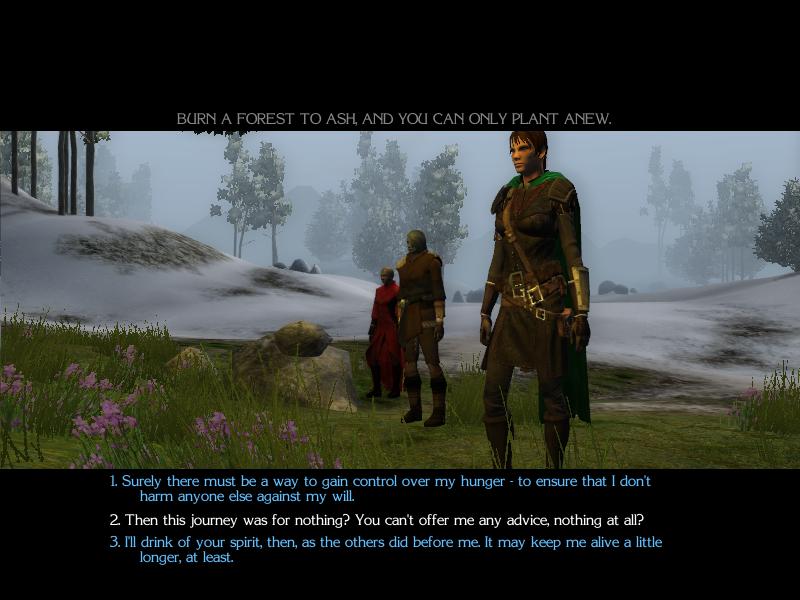
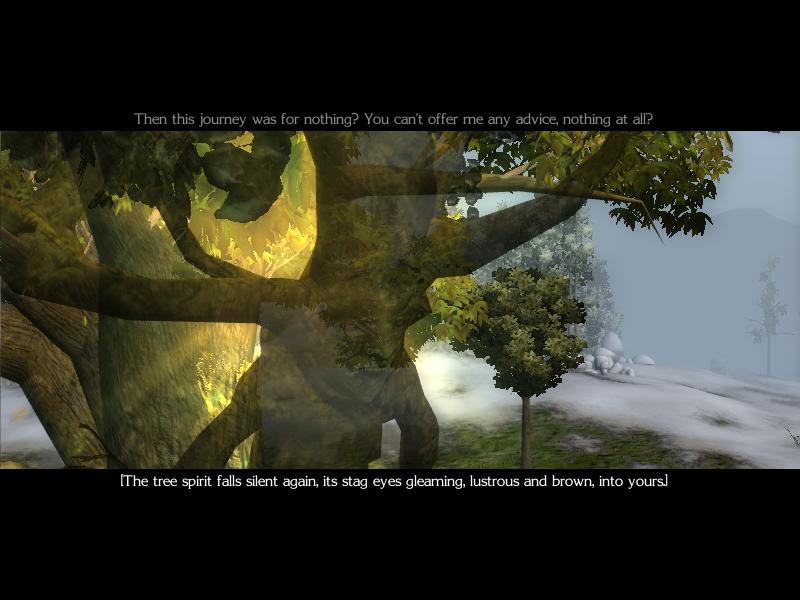

 : YOU CANNOT CHANGE ITS NATURE... BUT YOU CAN TEACH IT TO OBEY.
: YOU CANNOT CHANGE ITS NATURE... BUT YOU CAN TEACH IT TO OBEY. : [Insight] Then by channeling my spirit into the forest - into you - I might learn to control its ebb and flow?
: [Insight] Then by channeling my spirit into the forest - into you - I might learn to control its ebb and flow? : PERHAPS... YOU MIGHT DISCOVER A WAY TO RESTORE, AS WELL AS DEVOUR.
: PERHAPS... YOU MIGHT DISCOVER A WAY TO RESTORE, AS WELL AS DEVOUR.I ask you to think of the Wood Man as God because it sets the entire module in a new light. As I hinted earlier: we weren't running quests for Nadaj earlier, but rather consecrating the temple for the presence of God. The genius loci wasn't just some nature-themed end-boss for the module, but a false idol/demiurge-figure. And Nadaj wasn't 'enslaved' - she was the demiurge's avatar, its representative on Earth, like a Pope or Patriarch or what-have-you.
And when the Wood Man asks us to restore instead of devour, it is God's divine commandment to go forth and sin no more. The repression of base, animal urges in favour of a higher spiritual calling.
This may seem a bit random but have faith and all will be revealed.
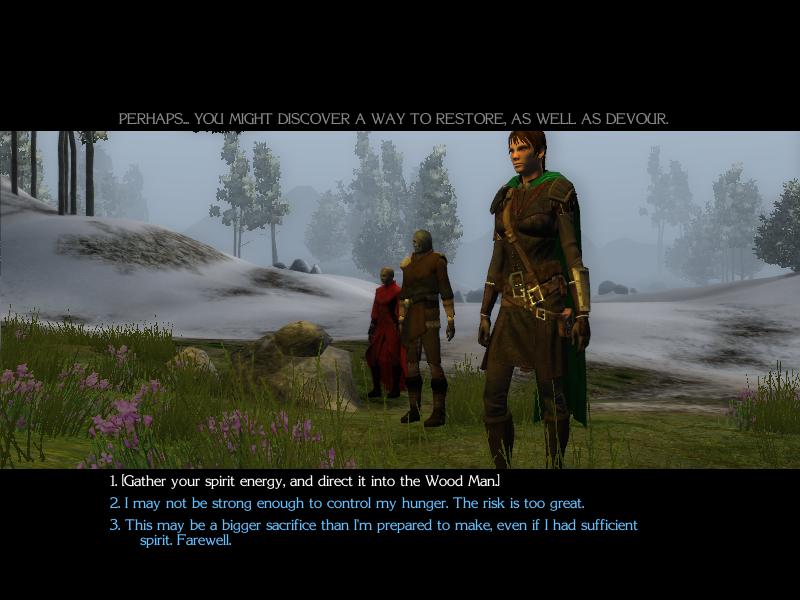
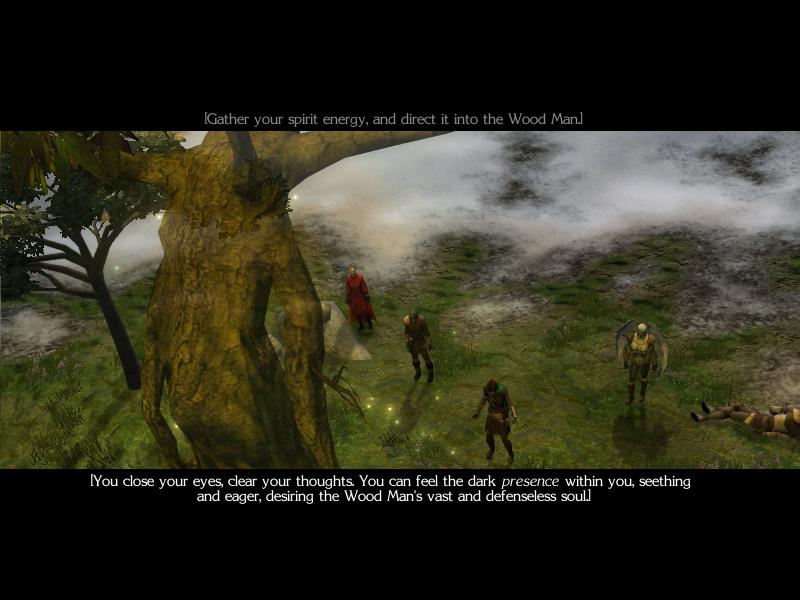
 : [But, you realize, your will has grown stronger since you first felt the stirrings of hunger... and you have gained a measure of power over the dark presence that lurks inside you.
: [But, you realize, your will has grown stronger since you first felt the stirrings of hunger... and you have gained a measure of power over the dark presence that lurks inside you. : [You take hold of that presence, meeting savage hunger with steadfast will... you command the presence to obey, to reverse the flow of life from yourself to the Wood Man... and the power surges forth...]
: [You take hold of that presence, meeting savage hunger with steadfast will... you command the presence to obey, to reverse the flow of life from yourself to the Wood Man... and the power surges forth...]
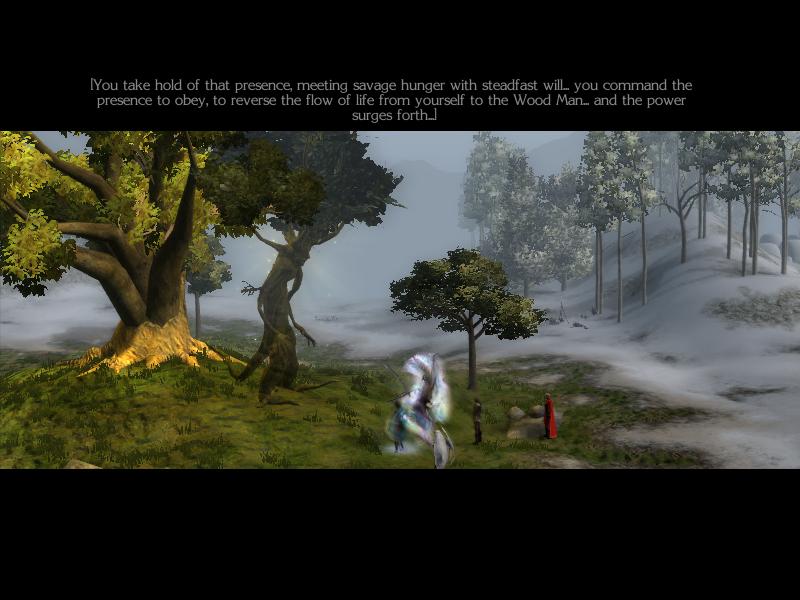
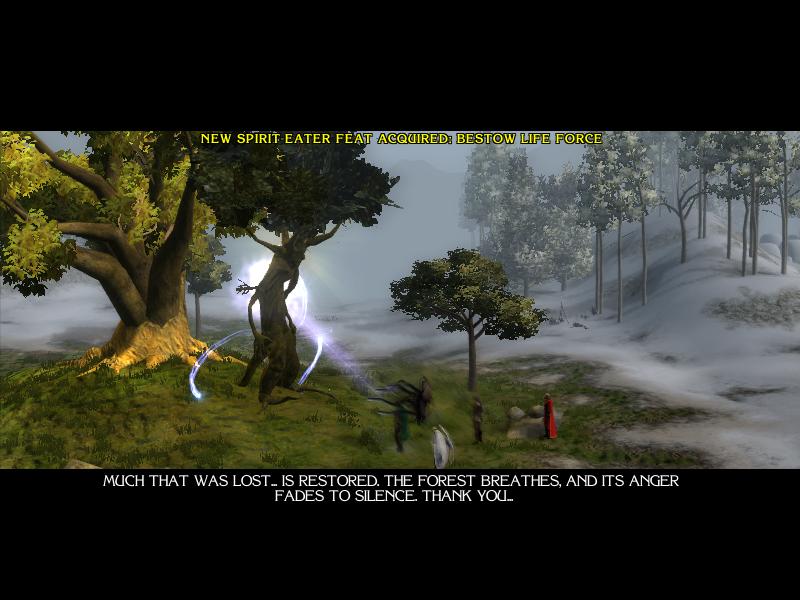
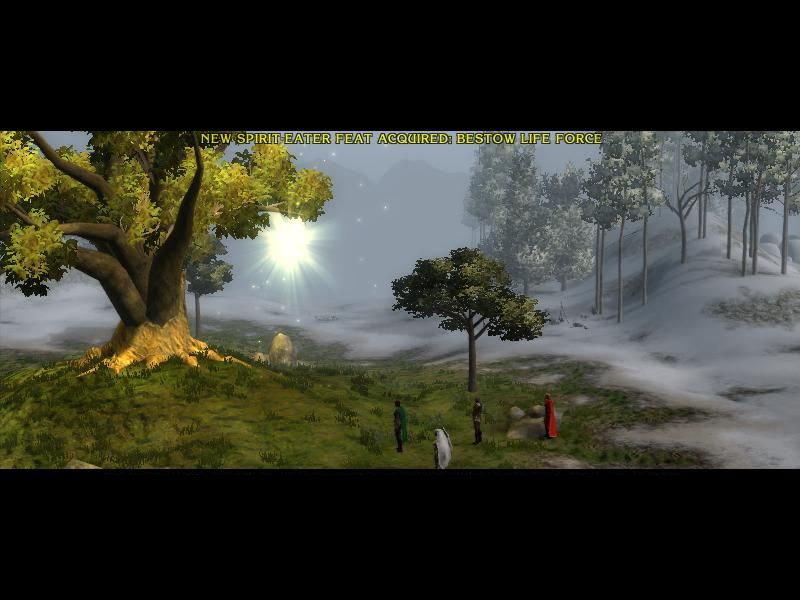
Bestow Life Force is a Good spirit power that lets us sacrifice up to one stage's worth of Spirit Energy for party-wide resurrection and healing. Nice, but unnecessary thanks to D&D's broken balance

